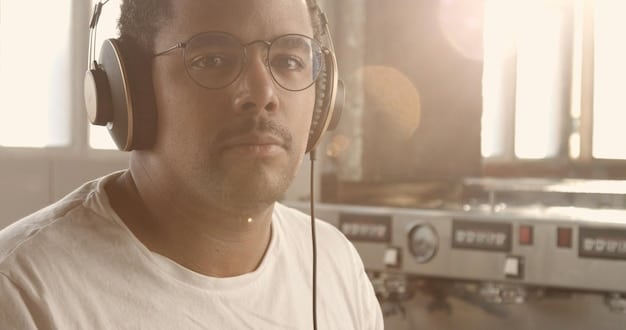Podcast Royalty Rate Increase: Impact on Creator Budgets

The proposed increase in royalty rates for music used in podcasts could significantly strain creators’ budgets, necessitating a careful reevaluation of content strategies and financial planning to maintain production quality and remain economically viable in a competitive landscape.
In the dynamic world of audio content, podcasts have emerged as a powerful medium for storytelling, education, and entertainment. However, recent discussions surrounding a proposed royalty rate increase for music in podcasts cast a significant shadow over the financial landscape for creators. Understanding how this potential change regarding Podcast News: How Will the Proposed Royalty Rate Increase for Music in Podcasts Affect Creators’ Budgets? involves delving into the intricacies of music licensing, its current costs, and the ripple effects such an increase could have on the diverse ecosystem of podcast production, from independent creators to large networks.
The Current Landscape of Music Licensing in Podcasting
The journey of a podcast from conception to listener’s ears often involves a delicate balance of creativity and compliance, especially when it comes to music. Currently, podcasters typically navigate a complex web of licensing agreements for any music they incorporate into their shows, whether it’s an intro jingle, background score, or featured tracks. These licenses are crucial because they ensure that artists and rights holders are compensated for their work, protecting intellectual property in the digital age.
Understanding the current structure is paramount before assessing the impact of any proposed changes. Podcasters generally opt for several types of licenses, each with its own set of rules and costs. These include:
Types of Music Licenses for Podcasters
- Synchronization Licenses: Required for using music in conjunction with visual media, which, in the podcasting context, can apply to video podcasts or any visual elements accompanying the audio. These are typically negotiated directly with the publisher and master recording owner.
- Mechanical Licenses: While more common for physical or digital reproductions, these can sometimes apply in podcasting if a musical work is reproduced (e.g., recorded directly into episodes).
- Performance Licenses: Administered by Performing Rights Organizations (PROs) like ASCAP, BMI, and SESAC in the US, these cover public performances of musical works. Podcasts, being publicly accessible, often fall under this category.
- Royalty-Free Music and Stock Libraries: Many podcasters use music from libraries that offer tracks for a one-time fee or subscription, often simplifying the licensing process by bundling various rights.
The costs associated with these licenses can vary wildly depending on the artist’s popularity, the usage duration, and the negotiation terms. Independent podcasters often rely on royalty-free or creative commons music to keep costs down, while larger productions might invest heavily in popular licensed tracks or custom compositions. This varied approach highlights the budget sensitivities already at play in the podcasting industry. Any change in the underlying royalty rates for licensed music would inherently disrupt these established frameworks, forcing creators to adapt their content strategies and financial models.
Understanding the Proposed Royalty Rate Increase
The discussion around a proposed increase in royalty rates for music in podcasts is not an isolated event but rather a piece of a larger puzzle involving the fair compensation of artists and rights holders in the digital era. These proposals often stem from the complexities of digital distribution, where content can reach millions across various platforms, sometimes with compensation models that are perceived as outdated or insufficient for creators of the underlying intellectual property.
Typically, such rate adjustments are deliberated and sometimes mandated by regulatory bodies or collective bargaining agreements between industry stakeholders. For instance, in the United States, organizations like the Copyright Royalty Board (CRB) periodically review and set statutory royalty rates for various forms of music usage. When a rate increase is proposed, it’s usually backed by arguments that current rates do not adequately reflect the economic value of the music consumed, the growth of the platform (podcasting in this case), or the inflation of production costs for artists.
Key Drivers Behind Proposed Increases
- Perceived Undervaluation: Rights holders often contend that the current royalty rates for podcast usage do not fully compensate for the reach and influence of music within this rapidly expanding medium.
- Market Growth: As podcast listenership and monetization grow, there’s a natural push for artists to share more significantly in that growth. The industry’s success fuels arguments for higher compensation for integral creative elements like music.
- Cost of Living and Production: The rising costs for music artists to produce, record, and market their work also play a role, as increased royalties can help them sustain their careers.
It’s important to note that these proposals rarely go unchallenged. They typically spark extensive debate among podcasters, their representative associations, music industry bodies, and legal experts. The potential impact on smaller creators and the viability of independent productions often form a core part of the opposition’s argument. The outcome of these discussions holds significant weight, not just for the immediate financial implications but for shaping the future economic model of podcasting as a whole, determining how music will be integrated and valued within audio narratives moving forward.
Direct Financial Impact on Podcast Creators’ Budgets
The most immediate and discernible effect of a royalty rate increase would be felt directly in the pocketbooks of podcast creators. Music, whether it’s a brief intro or extensive background scoring, is an integral part of many podcasts, contributing to branding, mood, and overall production quality. When the cost of this essential element rises, it inevitably triggers a domino effect on budget allocation and creative choices.
For independent podcasters, often operating on shoestring budgets, even a modest increase could translate into significant financial strain. Many currently rely on royalty-free music libraries or opt for tracks with less stringent licensing terms to keep costs manageable. A higher royalty rate might push these creators to make difficult choices, potentially leading to:
Budgetary Reallocations
- Reduced Production Quality: Creators might have to cut back on other crucial aspects of production, such as sound engineering, editing, or guest sourcing, to absorb increased music costs.
- Fewer Episodes: To maintain quality on a fixed budget, some podcasters might be forced to produce fewer episodes, impacting audience engagement and growth.
- Increased Monetization Pressure: The need to cover higher costs could accelerate the push for more aggressive advertising, sponsorships, or listener support, potentially altering the listening experience.
Larger podcast networks and media companies, while having more substantial financial resources, would also feel the pinch. They often license a higher volume of premium, well-known music, and a percentage-based increase on a larger base cost can quickly escalate into millions of dollars. This could lead to a re-evaluation of their content strategy, potentially favoring podcasts that rely less on licensed music or exploring more original compositions.
Moreover, the ripple effect extends beyond direct licensing fees. It could influence negotiations with composers for original scores, as the value proposition of licensed music shifts. Ultimately, the financial impact isn’t just about paying more; it’s about reshaping the economic viability of podcasting and potentially disadvantaging those who are already operating on razor-thin margins.

Strategic Adaptations for Podcasters
In the face of potential royalty rate increases, smart podcasters will already be contemplating strategic adaptations to mitigate the financial impact while maintaining the quality and appeal of their content. This foresight is crucial for long-term sustainability in a competitive and evolving audio landscape. The core challenge lies in balancing cost-efficiency with creative integrity, ensuring that budgetary constraints do not compromise the listener experience.
One of the most immediate strategies involves a deeper dive into existing music usage and exploring alternatives. This could mean a more conservative approach to music selection, perhaps reducing the number of licensed tracks per episode or shortening their duration. It also involves a shift towards more cost-effective music solutions.
Alternative Music Strategies
- Increased Use of Royalty-Free and Creative Commons Music: While some may perceive this music as less unique, the quality of royalty-free libraries has significantly improved, offering diverse genres and moods. Podcasters can explore these platforms more extensively to find suitable tracks that fit their show’s aesthetic without incurring recurring royalty costs.
- Commissioning Original Music: For those with the budget, commissioning custom-made intro/outro themes and incidental music from independent composers can be a valuable long-term investment. This music would be unique to the podcast, enhance brand identity, and avoid ongoing licensing fees from major rights holders.
- Leaning into Public Domain Music: Older musical works that have entered the public domain are free to use. While this limits genre and style, it can be a creative avenue for certain types of podcasts, particularly those with historical or classical themes.
Beyond music selection, podcasters might reconsider their overall content formats. Some might opt for more interview-based shows where music plays a minimal role, or explore spoken-word narratives that rely more on sound design and voice acting rather than extensive musical backdrops. This adaptation isn’t just about cutting costs; it can also be an opportunity to innovate and develop new auditory experiences that stand out.
Furthermore, strong financial planning becomes even more critical. This includes forecasting potential music costs based on projected increases and building these into annual budgets. For larger networks, this might involve negotiating bulk licensing deals or exploring umbrella agreements that cover wider usage rights more efficiently.
Ultimately, the ability to adapt will distinguish thriving podcasts from those that struggle. It requires creativity, business acumen, and a willingness to explore new avenues for sound and production within financial boundaries.
The Broader Industry Implications
A significant increase in music royalty rates for podcasts extends beyond individual creators’ budgets, casting wide ripples across the entire audio industry. This isn’t merely a financial adjustment; it has the potential to reshape business models, influence content trends, and even alter the competitive landscape. Understanding these broader implications is crucial for all stakeholders, from tech platforms to advertisers and talent agencies.
One of the immediate industry-wide effects could be a shift in bargaining power. If music licensing becomes substantially more expensive, larger podcast platforms and networks, with their greater negotiating leverage, might be better positioned to absorb or mitigate these costs. This could potentially deepen the divide between well-funded entities and independent creators, making it harder for new, smaller podcasts to gain traction if they cannot afford high-quality licensed music.
Potential Industry Shifts
- Content Diversification: There might be a noticeable trend towards content that is less reliant on licensed music, such as a surge in purely conversational podcasts, narrative non-fiction without musical scores, or shows featuring original soundscapes. This could lead to a less musically diverse podcast landscape.
- Increased Focus on Original Scores: As licensed music becomes more expensive, the value proposition of commissioning original music will increase. This could create a new niche for independent composers and sound designers specializing in bespoke podcast scores, potentially fostering new creative ecosystems.
- Platform Evolution: Major podcast platforms might be pressured to forge broader licensing deals directly with PROs and record labels, offering tiered access to music libraries as part of their services, potentially bundling these costs into their creator tools or monetization models. This could simplify licensing for individual podcasters but also centralize control over music usage.
Moreover, the advertising landscape could be affected. If podcasters face increased production costs, they may demand higher ad rates or more lucrative sponsorship deals to maintain profitability. This could put pressure on advertisers, potentially leading to a re-evaluation of podcast ad spending or a shift towards performance-based models.
The regulatory environment might also see increased activity. Debates around fair compensation for artists could intensify, leading to further legislative discussions or the establishment of new industry standards and best practices for digital audio content. This ongoing dialogue between creators, rights holders, and platforms will be critical in shaping the future economic framework for all forms of digital audio.
Advocacy and Future Outlook
The proposed royalty rate increase for music in podcasts is undeniably a critical juncture for the industry, prompting diverse stakeholders to consider advocacy and navigate an uncertain future. For podcasters, particularly independent ones, articulating their concerns and advocating for fair and sustainable rates is paramount. Collective action through industry associations and alliances can amplify these voices and ensure that the economic realities of podcast production are adequately represented in ongoing discussions.
Podcast industry associations, such as The Podcast Academy or the Podcast Movement, play a crucial role in lobbying efforts, commissioning economic impact studies, and facilitating dialogues with rights holders and regulatory bodies. Their objective is to strike a balance where artists are fairly compensated without stifling the growth and innovation within the podcasting ecosystem. This involves highlighting the unique creative and financial structures of podcasting, which differ significantly from traditional radio or streaming services.
Key Areas for Advocacy
- Economic Impact Studies: Providing robust data on how increased costs would disproportionately affect small and independent creators, potentially leading to a reduction in content diversity.
- Definition and Classification: Arguing for nuanced classifications of music usage in podcasts that reflect actual engagement and monetization models, rather than applying broad, sweeping royalties designed for other media.
- Negotiated Solutions: Pushing for voluntary collective licensing agreements or tiered royalty structures that are scalable and affordable for all levels of podcasters.
Looking ahead, the future of music in podcasts will likely be shaped by ongoing negotiations and technological advancements. While higher royalty rates present a challenge, they could also spur innovation. This might include the development of new AI-generated music tools, more sophisticated sound design techniques that reduce reliance on licensed tracks, or new partnership models between music artists and podcasters that bypass traditional licensing structures.
The industry will also likely see an even greater emphasis on intellectual property education for podcasters, ensuring they understand the complexities of licensing and compliance. This proactive approach can help prevent unintentional infringements and unnecessary legal costs, further optimizing their budgets. Ultimately, the outcome of these discussions will not just determine the cost base for music; it will define how creativity and commerce intertwine in the evolving world of audio content.
| Key Point | Brief Description |
|---|---|
| 💸 Budget Strain | Increased royalty rates mean higher operational costs, impacting production budgets significantly, especially for indie creators. |
| 🔄 Strategic Shifts | Podcasters may pivot to royalty-free music, commission original scores, or reduce music reliance to cut costs. |
| 🌐 Industry Impact | Affects competitive dynamics, drives content diversification, and could spark new platform licensing models. |
| ⚖️ Advocacy Efforts | Industry bodies advocate for fair rates, data-driven decisions, and sustainable compensation models for artists and creators. |
Frequently Asked Questions About Podcast Music Royalties
▼
A music royalty rate is the fee paid to artists and rights holders for the public performance or use of their copyrighted musical works within a podcast. These rates ensure proper compensation for intellectual property, covering various usage types like background music or theme songs, and are often managed by performing rights organizations.
▼
Proposals for royalty rate increases typically stem from arguments that current rates do not adequately compensate artists given the significant growth and increasing monetization of the podcast industry. Rights holders seek to ensure their compensation aligns with the evolving value and reach of their music in digital audio platforms.
▼
Independent podcasters, often operating on limited budgets, face disproportionate impacts from royalty rate increases. Higher music costs could force them to significantly reallocate funds, potentially leading to cuts in other production areas, fewer episode releases, or an increased reliance on less-expensive, royalty-free music, affecting overall show quality.
▼
Podcasters have several alternatives to mitigate increased music costs. These include extensively utilizing royalty-free music libraries, commissioning original music from independent composers for unique and perpetual rights, or exploring public domain music for specific genres. Some may also choose to reduce their overall reliance on music in their content format.
▼
Yes, podcast industry associations and advocacy groups actively engage in discussions and lobbying efforts to represent the interests of podcasters. Organizations like The Podcast Academy and Podcast Movement work to ensure fair and sustainable royalty rates, highlighting the economic impact on creators and fostering a balanced approach to artist compensation within the audio ecosystem.
Conclusion
The prospect of a royalty rate increase for music in podcasts presents a significant challenge for creators, necessitating a strategic reassessment of budgets and content creation workflows. While these changes aim to ensure fair compensation for artists, their implementation requires careful consideration of the podcasting industry’s unique economic structure, particularly the vulnerabilities of independent creators. The dialogue around these rates underscores the ongoing evolution of digital media compensation and highlights the creative adaptations and advocacy efforts that will define the sustainable growth of podcasting in the years to come. Ultimately, the ability to innovate and find new avenues for incorporating sound will determine how creators continue to captivate audiences while navigating an ever-changing financial landscape.





